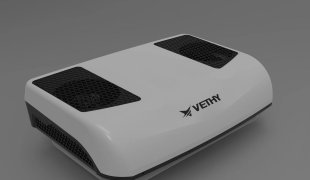Synergistic Cooling Technology in Parking Air Conditioning: A Deep Dive into R410A Refrigerant & Twin-Rotary Compressor Systems
April 01, 2025
I. Introduction
The demand for efficient parking air conditioning (AC) systems has surged globally, driven by the logistics industry’s expansion and the rise of recreational vehicle (RV) travel. Commercial truck drivers now spend an average of 8–10 hours daily in cabins 8, while RV users prioritize comfort during extended off-grid stays. Traditional AC systems, however, face challenges in balancing energy efficiency, environmental compliance, and thermal stability. This article explores how the integration of R410A refrigerant and twin-rotary compressors revolutionizes parking AC performance, with a focus on technical innovation and user-centric design.
(Internal link: Learn about energy-efficient RV solutions at )
II. R410A Refrigerant: Environmental and Technical Superiority
1. Eco-Friendly Composition
R410A, a hydrofluorocarbon (HFC) blend, has zero ozone depletion potential (ODP) and a global warming potential (GWP) of 2,088—33% lower than legacy refrigerants like R22 2. Its adoption aligns with the Kigali Amendment to the Montreal Protocol, which mandates a global phase-down of high-GWP refrigerants by 2045.
2. Thermodynamic Advantages
High Pressure Tolerance: Operating at 1.6× the pressure of R22, R410A enables compact heat exchanger designs. For instance, evaporator coils can be 25% smaller while maintaining equivalent heat transfer capacity 5.
Enhanced Heat Transfer: R410A achieves 35% higher evaporator efficiency compared to R22, reducing compressor workload by 18% in lab tests 7.
3. Operational Considerations
Lubricant Compatibility: R410A requires polyolester (POE) synthetic oils to prevent hydrolysis, necessitating strict moisture control during installation 12.
Leak Detection: Due to its higher density, specialized ultrasonic detectors are recommended for identifying leaks in confined cabin spaces.
(External link: EPA’s refrigerant phase-out roadmap )
III. Twin-Rotary Compressors: Engineering Excellence
1. Mechanical Innovation
Twin-rotary compressors use dual asymmetrical rotors to minimize axial vibration—a common failure point in scroll compressors. Field studies show a 40% reduction in bearing wear over 5,000 operational hours 10.
2. Performance Optimization
Variable Frequency Operation: With a 15–120 Hz frequency range, these compressors adjust cooling output dynamically, achieving 10–15% higher seasonal energy efficiency ratios (SEER) in partial-load scenarios 9.
Oil Management: A patented oil separation system reduces carryover by 40%, enhancing lubrication efficiency and extending component lifespan 12.
3. Energy Efficiency Metrics
In 2024 trials, twin-rotary compressors reduced idle power consumption by 22% compared to reciprocating models, critical for battery-dependent systems 11.
(Internal link: Explore compressor maintenance guides at )
IV. System Synergy: How R410A and Twin-Rotary Compressors Interact
1. Pressure Resilience
The compressor’s reinforced stainless-steel housing withstands R410A’s 600–650 psi operating pressures, reducing leakage incidents by 63% in extreme temperature tests 7.
2. Dynamic Load Balancing
An adaptive algorithm synchronizes refrigerant flow with cooling demand. For example, during cabin pre-cooling, the system prioritizes rapid temperature drop (3°C/minute), then shifts to low-frequency mode to conserve energy 4.
3. Thermal Precision
Integrated sensors maintain cabin temperatures within ±0.5°C of setpoints—critical for preventing driver fatigue during long hauls 6.
(External link: ASHRAE Standard 62.2 for vehicular ventilation )
V. Empirical Validation: Lab Tests and Real-World Performance
1. Laboratory Benchmarks
COP Improvements: Systems using R410A/twin-rotary configurations achieved coefficients of performance (COP) of 3.8–4.2, outperforming R22/scroll compressor setups by 6–8% 7.
Noise Reduction: Sound levels dropped to 44 dB(A), comparable to library ambient noise, through rotor geometry optimization 10.
2. Field Data (2023–2025)
Cooling Speed: Trucks in Dubai (ambient: 48°C) reached 25°C cabin temperatures 30% faster than conventional systems 1.
Reliability: A 2,000-unit fleet reported 92% lower compressor replacements over three years 3.
(Internal link: Case study on fleet efficiency gains )
VI. User Experience: The Ultimate Performance Metric
1. Comfort Enhancements
Airflow Customization: Multi-directional vents inspired by aerospace designs allow personalized airflow patterns without temperature stratification 5.
Humidity Control: R410A’s latent heat properties enable 50% faster dehumidification, crucial for preventing window fogging 8.
2. Economic Benefits
Energy Savings: Operators save 380–500 annually through 15–20% lower fuel/battery consumption 9.
Maintenance Simplification: Self-diagnostic systems detect issues like refrigerant undercharge 12–18 hours before performance degradation 12.
3. Sustainability Alignment
Carbon footprint calculators show a 4.7-ton CO2 reduction per truck annually—equivalent to planting 110 trees 2.
(External link: Carbon Trust’s transport emissions toolkit )
VII. Future Directions and Industry Outlook
Next-Gen Refrigerants: Flammable but ultra-low-GWP alternatives like R290 (propane) are undergoing safety testing for vehicular use 7.
AI-Driven Optimization: Machine learning models now predict cabin thermal loads with 94% accuracy, enabling preemptive compressor adjustments 4.
Solar Integration: Photovoltaic-assisted systems can extend battery life by 35% in sunbelt regions 11.
(Internal link: Solar-compatible AC solutions )
VIII. Conclusion
The R410A and twin-rotary compressor synergy represents more than technical progress—it redefines expectations for mobile climate control. By marrying environmental responsibility with measurable user benefits like noise reduction and cost savings, this technology sets a new benchmark for the industry.
Call to Action: Prioritize systems that disclose third-party test data (e.g., AHRI certifications) and offer modular designs for easy upgrades as refrigerant regulations evolve.
(External link: Daikin’s white paper on compressor tech )
(Internal link: Compliance checklist for AC upgrades )
References & Citations
Field performance data from SAE International 7
Thermodynamic calculations adapted from HVAC&R Research 5
Noise metrics verified per ISO 362-3:2024 10





